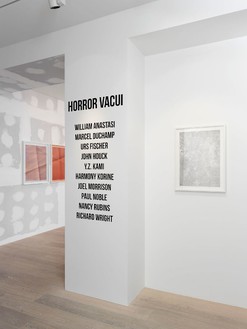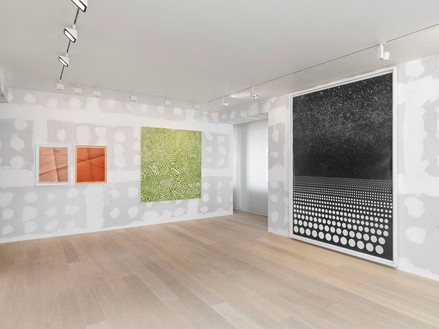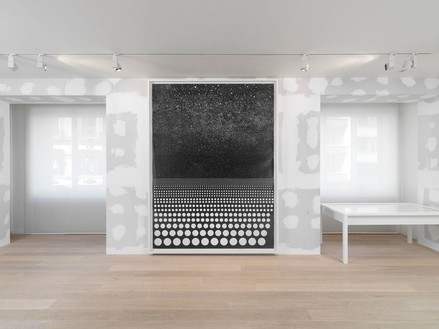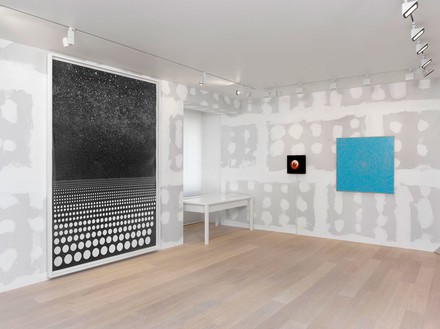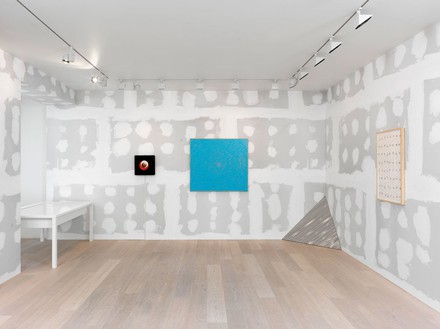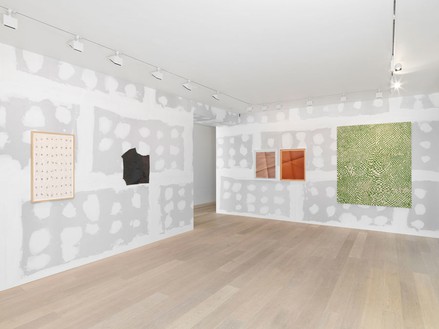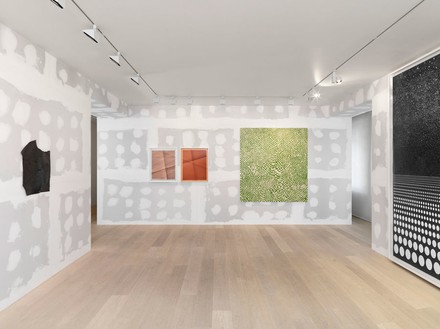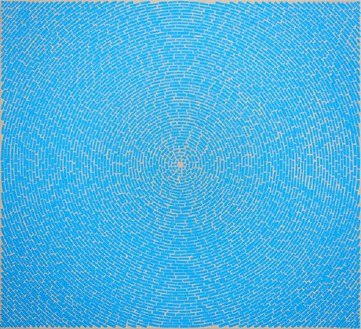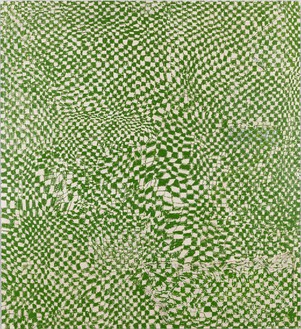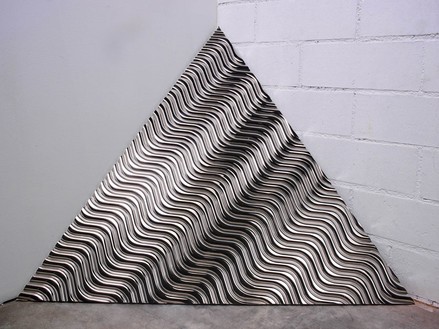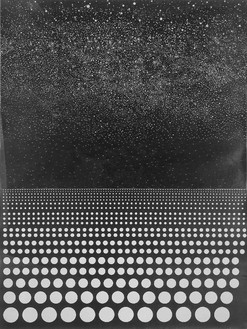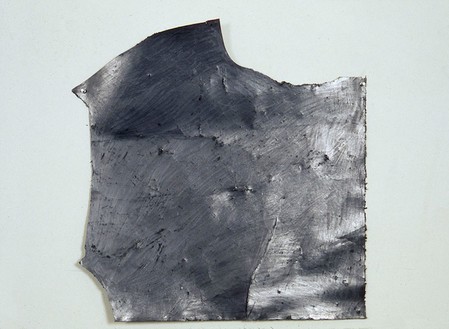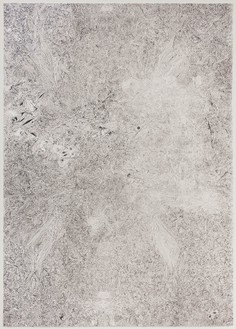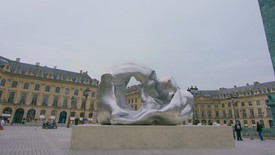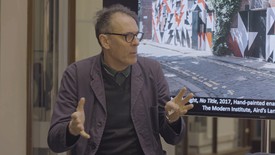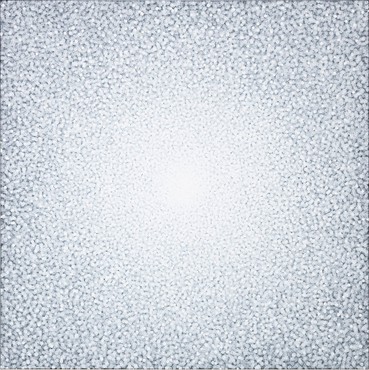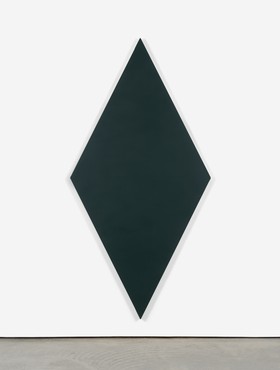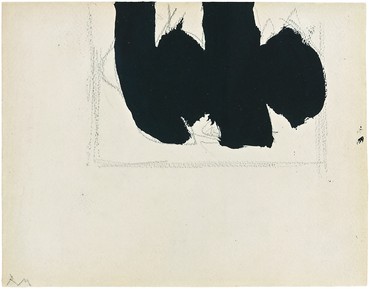About
“Horror vacui,” or “fear of empty spaces,” is a term often used to describe outsider art, where every square inch of surface is filled with details and data in a compulsive excess of activity—perhaps in fear of that blank space that might stare back. In opposing the void, every particle is given form. The group exhibition Horror vacui proposes Op art as a side effect of this embattled triage of hand, eye, and mind, where mark making is a means with which to fill space with optically rich results.
As an antidote to aesthetic gratification, Marcel Duchamp invented the Rotoreliefs in 1923. By satisfying the retina itself, they mesmerized the eye with gyrating spirals. The result was a hypnotic visual white noise as well as a false sense of depth or vortex. Duchamp enlisted his product in an inventors’ fair, sure that this would reveal its niche market demographic. Not a single Rotorelief sold.
A vacuum neutralized of the burdens of detail, the white cube has long been considered an unencumbered and timeless context for viewing art. Urs Fischer’s playful wallpaper imitates the appearance of raw sheetrock, an odd moment of past-life mimesis for the walls in a room that now communicates the sensation of an indeterminate space. The corners of rooms are where planes converge and space is rendered functionally useless and thus often ignored, yet Joel Morrison’s shiny stainless-steel corner piece converts this uselessness into a glaringly prominent strength, just as Rachel Whiteread uses the entire space itself as a sculptural material.
The hours spent applying and reapplying a totality of marks are evident in the dense graphite drawings of Nancy Rubins. Torn papers are rubbed vigorously with graphite so as to appear burnished like dull, dark metal. Made by scribbling onto the paper contained inside of his pocket with a pencil cramped in his hand, William Anastasi’s Pocket Drawings act as a diaristic account of this space within everyday attire as an active site of mark making. The late Roman Opalka spent a lifetime documenting time and space by painstakingly counting toward infinity. His works on paper entitled Cartes de Voyage demonstrate his conviction, done outside the studio out of necessity.
L’expression «Horror vacui» ou «peur des espaces vides» est souvent utilisée pour décrire l’art brut, qui consiste, dans un excès compulsif, à couvrir de détails et de données chaque centimètre carré de surface—sans doute par peur d’un retour des espaces vides. En s’opposant au vide, l’art brut donne forme à chaque particule. Il fait de l’art optique un effet secondaire de cet affrontement entre la main, l’œil et l’esprit, où le mark making apparait comme un moyen de pouvoir saturer l’espace en proposant une œuvre optiquement riche.
Comme antidote à la satisfaction esthétique, Marcel Duchamp a inventé les Rotoreliefs en 1923. En captivant la rétine elle-même, les Rotoreliefs magnétisent l’œil par le jeu de motifs en spirale. Il en résulte une œuvre hypnotique, à la fois un bruit de fond visuel et un faux sentiment de profondeur ou vortex. Duchamp a présenté son œuvre au concours Lépine, persuadé de pouvoir s’ouvrir un nouveau marché. Il n’en a pas vendu un seul.
Le cube blanc a longtemps représenté un vide protégé du fardeau des détails pour devenir un espace inutilisé et intemporel propice à la visualisation de l’art. Le papier peint ludique de Urs Fischer imite l’apparence de plaques de plâtre brut pour représenter un moment étrange de mimésis du temps passé à travers les murs d’une pièce, qui donne alors la sensation d’un espace indéterminé. Les coins de la pièce marquent le lieu où les points convergent et où l’espace est rendu fonctionnellement inutile et donc souvent ignoré. L’œuvre d’angle en acier inoxydable brillant de Joel Morrison convertit cette inutilité en une force imposante et éclatante. C’est l’espace tout entier, qu’il soit oublié ou invisible, qu’utilise Rachel Whiteread comme matériau dans ses sculptures.
Les heures passées à appliquer et à réappliquer une complétude de marques apparaissent clairement dans les denses dessins au graphite de Nancy Rubins. Des papiers déchirés sont frottées vigoureusement au graphite de manière à leur donner les reflets du métal brossé mat. Fabriqué à partir du griffonnage de papiers contenus dans sa poche à l’aide d’un crayon serré dans sa main, les dessins de poche de William Anastasi sont une narration au quotidien de cet espace, tel que nous le connaissons, en tant que lieu actif du mark making. Le défunt Roman Opalka a consacré toute une vie à témoigner du temps et de l’espace en comptant vers l’infini. Ses Cartes de Voyage, réalisées par nécessité sur papier en dehors de son studio, témoignent de sa conviction.
La répétition obsessionnelle et le griffonnage inconscient peuvent recéler de puissants champs optiques susceptibles, par l’utilisation de codes personnels et de rythmes modélisés, d’infléchir la planéité de la toile. Les œuvres de Harmony Korine ondulent de manière agressive dans des motifs vichy psychédéliques et asymétriques. Les Agrégats de John Houck repensent le pixel par des moyens récursifs, comme une série de combinaisons possibles travaillées jusqu’à une extrémité infinitésimale.
Liste des artistes à Genève : William Anatashi, Marcel Duchamp, Urs Fischer, John Houck, Y.Z. Kami, Harmony Korine, Joel Morrison, Paul Noble, Nancy Rubins, Richard Wright
Liste des artistes à Athènes : William Anatashi, Urs Fischer, John Houck, Bruce Nauman, Roman Opalka, Richard Phillips, Nancy Rubins, Despina Stokou, Piotr Uklański, Rachel Whiteread, Richard Wright
Urs Fischer: Wave
In this video, Urs Fischer elaborates on the creative process behind his public installation Wave, at Place Vendôme, Paris.
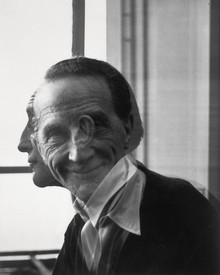
Still Life, Still
Harry Thorne reflects on Brian O’Doherty’s recording of Marcel Duchamp’s heart.

Now available
Gagosian Quarterly Summer 2023
The Summer 2023 issue of Gagosian Quarterly is now available, featuring Richard Avedon’s Marilyn Monroe, actor, New York, May 6, 1957 on its cover.
In Conversation
Richard Wright and Martin Clark
Richard Wright and Martin Clark, director of Camden Art Centre, London, discuss Wright’s latest body of work, recent commissions, and new monograph, which provides a comprehensive overview of his practice between 2010 and 2020.
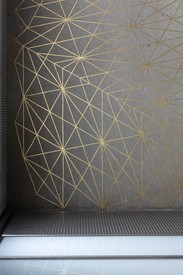
No Title
In an excerpt from his forthcoming monograph, Richard Wright pens a personal and philosophical text about painting.

Now available
Gagosian Quarterly Winter 2022
The Winter 2022 issue of Gagosian Quarterly is now available, featuring Anna Weyant’s Two Eileens (2022) on its cover.
